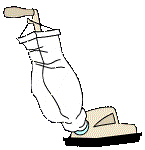1. a small, soft-bodied mollusk that crawls very solwly. Most snails have spiral shells on their backs into which they can pull back for protection. There are land snails, freshwater snails, and marine snails. Snails are gastropods.
2. Figurative. a lazy, slow-moving person; That janitor is a snail who never gets things done. syn: sluggard
![]() Back to top
Back to top
 Comments
CommentsSnails are an easy addition to the classroom. All you have to do is find just one... and then your class will bring in far more than you need! Snail collecting becomes a lot like rock collecting, there’s always one more coming into the classroom once you start. Spring is a good time for this activity. There are lots of snails around, and you won’t be faced with 10 months of new additions! Also, Spring is mating time for snails.
I like to keep a maximum of four snails in a gallon jar. You don’t have to worry about getting males or females because they are hermaphroditic (have male and female parts). If you provide a soil base, you will undoubtedly get eggs. They even seem to prefer to lay them against the glass! Sometimes I keep a “short term” jar which is full of as many snails as we can find, just to see the individual differences. My “resident jar” has a limited number because I like to keep a handle on the “clean -up” involved. At the end of the activity, I can simply let the snails go (but not near anyone’s garden!)
![]() Back to top
Back to top
Your container needs a well fitting cover that provides ventilation, but does not allow the babies ( about 2 mm) to escape. A small (5 1/2 gallon) aquarium is more than adequate, but you probably would want to save this tank for something else. A gallon (pickle) jar turned on its side is my usual housing. A plastic “bulk foods” jar would work well too. A simple stand can be made from a Kleenex box. The lid can be cut from a plastic acetate sheet or from a plastic food container. This is better than using a metal jar lid because you don’t want to punch holes which leave sharp edges on either the inside or the outside. A thin layer of gravel for drainage is topped with soil. Moss or leaf litter can also be added. Sticks look attractive, but unless they are easy to remove they will make cleaning difficult.
![]() Back to top
Back to top
Leftover scraps of vegetables (lettuce) or peelings (carrot, potato, apple) are sufficient. Simply place them right on the soil. Replace any molding food. Water can be added by a misting every couple of days, but don’t get the container too wet.
![]() Back to top
Back to top
 Maintenance
MaintenanceThe glass sides should be wiped clean with a damp cloth about once a week. As this is not usually a long term study, you will not need to change the soil. Keep an eye on the general humidity. The tank should be a little damp but not wet.
![]() Back to top
Back to top
Phylum: Mollusca Class: Gastropoda
Snails have been around for at least 500 million years, which dates them back to some of our oldest fossils. They are a very successful animal, having more than 80,000 species. Saltwater snails are the most prolific, having about 55,000 species. Some snails are smaller than a pinhead while a few grow to 61 cm (2 ft.) They may live from 2 to 20 years. They are found in almost every habitat, be it damp land, fresh water, or sea water. Snails have many enemies. Birds, small mammals such as mice and squirrels, turtles, fish, frogs, salamanders, and humans all help to keep these prolific species in check.
![]() Back to top
Back to top
 Characteristics
Characteristics• The snail’s most defining characteristic is its spiral shell, which is a living part of its body. The shell grows along with the snail, and provides a retreat in times of danger. During dry periods, land snails can secrete a mucus “door” which dries to seal themselves, and a humid atmosphere, inside. Most sea snails have a lid-like part, called an operculum, which serves to close the entrance.
• Snails crawl along by a large, muscular foot. As the muscles ripple, a lubricating slime is secreted to help the snail glide over any type of terrain. They can slide over sharp glass and up walls or plants in this way.
• The snail’s head is actually a part of the foot. Most land snails have two pairs of tentacles, whereas aquatic snails generally have just one pair. Eyes are either at the base or the tips of the upper tentacles. The little eye bulge is quite visible in most land snails. Vision is poor. The lower tentacles are usually smaller and are generally used to probe the surface. These provide information regarding smell and touch.
• The mouth is under the head. The tongue acts like a cheese grater, scraping off bits of food. Snails are primarily herbivores, although some will partake in a meal of a dead animal if the opportunity arises.
• Internal organs, such as the heart, remain inside the shell. Most aquatic snails have gills, but land snails have a breathing chamber. The land snail’s breathing pore can be seen as a small hole on the right side of the body, just inside of the shell. Some freshwater snails also have this breathing chamber, and so must occasionally come to the surface for air. Another hole in this region is linked to the intestines, and is used to expel wastes.
• Land snails are hermaphroditic, that is, each snail has both male and female parts. They still must mate to reproduce, however. A hole near the head is the genital orifice where the snail mates and also where it lays its eggs. Aquatic snails have both hermaphroditic and heterosexual reproduction. Virtually all snails lay eggs.
![]() Back to top
Back to top
• Study the basic anatomy of the snail. Look for the shell, head, foot, two pairs of tentacles, eyes, and breathing pore. Look for the spiral pattern on the shell. Compare the coloration and patterns of different shells.
• Observe a snail’s movements over different surfaces, up different inclines, and from underneath by having it move over a piece of glass or clear plastic.
• Touch a snail gently to observe the reaction of the tentacles.
• Vary the living environment at opposite sides of your container (eg. dampness, choice of substrates, amount of coverings, food supply, type of foods etc.) and discover what your snails prefer.
• See if the snails are attracted by different amounts of light, foods, smells etc.
![]() Back to top
Back to top
Brillon, Gilles, Young Naturalist 1: Discovering Spiders, Snails and Other Creepy Crawlies, Quebec: Quintin Publishers, 1992, pp. 28-44.
Johnson, Kipchak, Worm’s Eye View - Make Your Own Wildlife Refuge, Brookfield, Conn.: The Millbrook Press, 1991, pp. 19-22.
Kramer, David C., Animals in the Classroom, U.S.A.: Addison-Wesley, 1989, pp.39-46.
Olesen, Jens, Snail (Stopwatch Books), London: A & C Black Publishers Ltd., 1985
Reily, John, Do Snails Know Which Way is Up? (FLASH Elementary Science Project), Maple Ridge, B.C.: School District No. 42 (Maple Ridge - Pitt Meadows), 1995 (?)
Swanson, Diane, A Toothy Tongue and One Long Foot, Vancouver/Toronto: Whitecap Books, 1992 pp. 8-10.
![]() Back to top
Back to top
All About Snails
An excellent introduction to snails by a teacher.
http://www.geocities.com/sseagraves/allaboutsnails.htm
Frescargot Farms
They “assist those who are interested in snails and developing a backyard snail farming program”, but are geared for small business really. Interesting to visit!
http://www.etropolis.com/snails/index.htm
Mollusks -- Bibliography Non-Marine (Revised October 22, 1995)
This bibliography was adapted from the book Freshwater Mussels of the Tennessee
River http://fly.hiwaay.net/~dwills/bks_id.html#land
SlugWeb... it seems that the banana slug is famous in movies and as a mascot
of the University of California, Santa Cruz
http://slugweb.com/slugweb/index.phtml
Snails - Photos, artwork, drawings!
http://www.lingsoft.fi/~simon/gallery/snails/index.html
Snails - A neat little package which sends you off to lots more sites!
http://ast.leeds.ac.uk/~agg/snails.html
All About Snails
http://www.kiddyhouse.com/Snails/
Raising Snails
http://www.nal.usda.gov/afsic/AFSIC_pubs/srb96-05.htm
| Getting around in this Web site |